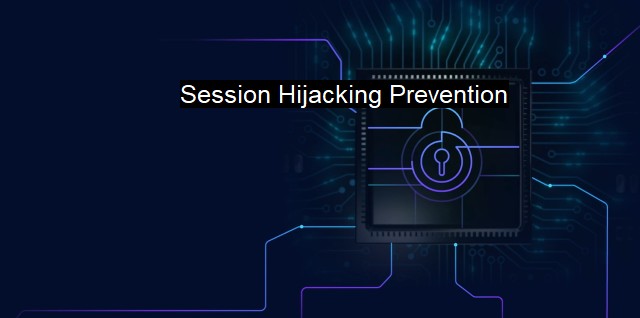What is Session Hijacking Prevention?
Preventing Session Hijacking: Techniques and Methods to Secure Your Computer Network System from Cyber Attacks
"Session hijacking prevention" is a critical component in the industry of cybersecurity and antivirus protection. As technology continues to evolve rapidly, the threats that unethical hackers present to a company's or individual's cybersecurity also adapt. Among these multitude threats, session hijacking is increasingly becoming a major concern.So what exactly is session hijacking? It's a type of attack where an intruder takes over a legitimate user's session while they are connected to a network. These "sessions" represent the communication between a client's computer (like a laptop or smartphone) and a server (which hosts websites or processes online payments). When a user logs into a website, starts an application, or initiates any other digital process, a session is created between their device and the system they are connecting to. Unfortunately, these sessions can be highjacked, hence the term "session hijacking".
Bear in mind that session hijacking is incredibly perilous. The hijacker can interact with the server pretending to be the original user once the session is hijacked. This allows the attacker to perform any fraudulent activity under the hijacked identity.
Having established its implications, let's delve into the importance of session hijacking prevention. The advent of cybersecurity has provided ways to make this task achievable. Multiple methods can be employed for this; user authentication, session timeouts, encryption, token handling, IP address verification, and secure cookies to name a few.
User authentication presents the first barrier to hijackers. This usually requires the user to enter credentials - usernames, passwords, or other personal identifying information. Multi-factor authentication which requires more than one piece of evidence to verify the user's identity, and one-time passwords sent to the user's mobile device, are other additions to improve authentication. Although authentication itself isn't infallible, its strength lies in its use as a solid foundation for other prevention methods.
Setting session timeouts can mitigate the risk presented by idle users. These inactive sessions can pose juicy easy targets for hijackers, and simply timing out these sessions after a certain period can drastically reduce this risk.
Strong encryption methods play a vital role in preventing session hijacking. Encryption works by converting usable information into scrambled data. When this data is intercepted by intruders, they will only have meaningless scrambled information even if they succeed.
Tokens are random, unique strings assigned to a user's session. Recognizing abruptly changed, duplicate or otherwise uncharacteristic tokens and invalidating these sessions can prevent many potential attacks.
Monitoring IP addresses is equally resourceful in combating session hijacking. If an active session's IP address changes unexpectedly, it relates high chances of session hijacking. By monitoring any sudden changes, companies can terminate sessions just in case
The choice to use secure cookies can offer another formidable niche to curtail this threat. Cookies, similar to sessions, store a user's browsing information, and opting to incorporate versions harder to hijack can provide considerable prevention
Antivirus software providers often bake these methods directly into their products, such assistance lifts much of the burden from users and companies who cherish data privacy.
This highlights the necessity of session hijacking prevention within cybersecurity and antivirus solutions. By ensuring strong user authentication, employing encryption methods, setting session timeouts, and enforcing stringent token and IP address rules, businesses and individuals alike can work to ensure they retain control of their private sessions, thwarting hijackers at every possible juncture.

Session Hijacking Prevention FAQs
What is session hijacking and why is it dangerous?
Session hijacking is a type of cyber attack where an attacker intercepts and takes control of an ongoing session between a user and a web application. This allows the attacker to access and manipulate sensitive information, such as login credentials, personal data, and financial information. It can be dangerous because it can lead to identity theft, financial loss, and other forms of cybercrime.What are some common techniques used in session hijacking attacks?
Some common techniques used in session hijacking attacks include cross-site scripting (XSS), cross-site request forgery (CSRF), session fixation, sniffing, and man-in-the-middle (MitM) attacks.What are some best practices for preventing session hijacking?
Some best practices for preventing session hijacking include using secure transport protocols (e.g., HTTPS), implementing multi-factor authentication, using secure cookies, regularly updating and patching software and operating systems, using strong encryption and authentication mechanisms, and monitoring network traffic for suspicious activity.Can antivirus software help prevent session hijacking attacks?
Antivirus software can help prevent session hijacking attacks by detecting and blocking malicious code and malware that could be used in such attacks. However, it is not a foolproof solution and should be used in conjunction with other security measures, such as firewalls, intrusion detection and prevention systems, and user education and awareness programs.| | A | | | B | | | C | | | D | | | E | | | F | | | G | | | H | | | I | | | J | | | K | | | L | | | M | |
| | N | | | O | | | P | | | Q | | | R | | | S | | | T | | | U | | | V | | | W | | | X | | | Y | | | Z | |
| | 1 | | | 2 | | | 3 | | | 4 | | | 7 | | | 8 | | |||||||